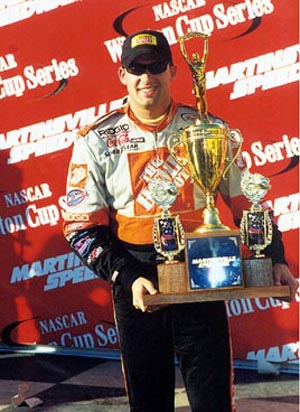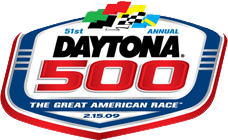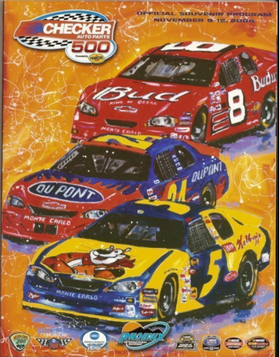Related Research Articles

The 2005 NASCAR Nextel Cup Series was the 57th season of professional stock car racing in the United States and the 34th modern-era Cup series. The season began on Saturday, February 12. The ten-race Chase for the Nextel Cup started with the Sylvania 300 on Sunday, September 18, and ended on Sunday, November 20, with the Ford 400.

The GEICO 500 is a NASCAR Cup Series stock car race held at the Talladega Superspeedway in Lincoln, Alabama. The race is usually held in April or May. The 1997 event stands as the fastest NASCAR race to date ever run with an average speed of 188.354 miles per hour (303.126 km/h) and was the first race at Talladega Superspeedway that was not interrupted by a caution period.

The YellaWood 500 is a NASCAR Cup Series stock car race held at Talladega Superspeedway in Lincoln, Alabama, hosting an event in the NASCAR playoffs. The race is one of four NASCAR Cup Series races currently run with tapered spacers, the others being the GEICO 500 in May, the Coke Zero Sugar 400, and the Daytona 500. Through 1996, this race was normally held in early August or late July. In 1997, it was moved to early October due to the uncomfortably hot summer temperatures, and sometimes unpredictable summertime thunderstorms in the Alabama area. In 2009, the race moved again, this time to November 1 as part of a realignment agreement with Atlanta and Fontana.

The 2006 NASCAR Nextel Cup Series was the 58th season of professional Stock car racing in the United States and the 35th modern-era NASCAR Cup series season. It was started at Daytona International Speedway on Sunday, February 12 with the Budweiser Shootout and ended on Monday, November 20, with the Ford 400 at Homestead-Miami Speedway. The Chase for the Nextel Cup began with the Sylvania 300 on Sunday, September 17, at New Hampshire International Speedway. This was the last full-time season with the Gen 4 car.

The 2003 NASCAR Winston Cup Series was the 55th season of professional stock car racing in the United States and the 32nd modern-era Cup Series season. The season began on February 8 at the Daytona International Speedway with the Budweiser Shootout and ended on November 16 at Homestead-Miami Speedway with the Ford 400. Despite only winning one race throughout the whole season, Matt Kenseth, driving the No.17 Ford for Roush Racing, was strongly consistent following the lone win, and was crowned the Winston Cup champion. His only win came in the third race of the 36 race season. Chevrolet took home the NASCAR Manufacturers' Championship after capturing 19 wins and 264 points over second-place finisher Dodge, who had nine wins and 203 points. Ford finished the year third with seven wins and 200 points, and Pontiac finished fourth with one win and 125 points.

The 2002 NASCAR Winston Cup Series was the 54th season of professional stock car racing in the United States and the 31st modern-era Cup Series season. It began on February 10, 2002, at Daytona International Speedway, and ended on November 17, 2002, at Homestead-Miami Speedway. Tony Stewart, driving for Joe Gibbs Racing, was declared as the Winston Cup champion. Bill Elliott won the 2002 NASCAR's Most Popular Driver Award. He would win it for the 16th and final time in his career. He withdrew from the ballot after receiving the award. The NASCAR Manufacturers' Championship was captured by Ford after winning 14 events and gaining 245 points over second-place finisher Chevrolet, who had 10 wins and 211 points.
In North American auto racing, a green–white–checker finish (GWC) is a racing restart procedure one in which the race is restarted from a caution period with 2 laps remaining. When the race distance is extended to accommodate such a finish, it is also sometimes known as an overtime finish or stage four. The name alludes to three racing flags:

The 2007 Daytona 500, the 49th running of the event, was the first race of the 2007 NASCAR Nextel Cup Series season, taking place on February 18, 2007, at Daytona International Speedway in Daytona Beach, Florida. Kevin Harvick won the race by 0.02 second over Mark Martin in the closest finish since the first race at Daytona International Speedway when it took three days to declare Lee Petty the winner in 1959. The race was decided by a green-white-checker finish for the third year in a row, with two extra laps added for a total of 202 laps and 505 miles (813 km).

The 2009 Daytona 500, the 51st running of the event, was held on February 15, 2009, at Daytona International Speedway in Daytona Beach, Florida as the first points-paying race of the 2009 NASCAR Sprint Cup season and the last 500 of the 2000s decade. The race was won by Matt Kenseth, making a car numbered 17 winning the race for the first time in 20 years since Darrell Waltrip's win back in 1989 and the first Daytona 500 win for Roush Fenway Racing. The race was called off with 48 laps to go after a severe rainstorm that had been lingering throughout the area hit the track.

The 2010 Daytona 500 was the first stock car race of the 2010 NASCAR Sprint Cup Series. The 52nd Daytona 500, it was held on February 14, 2010, in Daytona Beach, Florida, at Daytona International Speedway, before a crowd of about 175,000 attendees. Earnhardt Ganassi Racing's Jamie McMurray won the 208-lap race from 13th place. Dale Earnhardt Jr. of Hendrick Motorsports finished in second, and Roush Fenway Racing's Greg Biffle was third.

The 2003 Aaron's 499 was held on April 6, 2003, at Talladega Superspeedway in Talladega, Alabama. It was the eighth race of 36 in the 2003 NASCAR Winston Cup Series season. Jeremy Mayfield was the polesitter.
The 2001 edition of The Winston was held on May 19, 2001, at Lowe's Motor Speedway in Concord, North Carolina. This was the 17th running of the event. The race is mostly remembered for the start, when rain progressed onto the track, causing cars to get loose and crash into the wall. One of the first ones to crash was Kevin Harvick, in his first appearance at the speedway. Then Jeff Gordon got sideways and wrecked after tapping Jeff Burton from behind, then Michael Waltrip wrecked Gordon, destroying his car, at which point the race was stopped. All of the drivers returned with back-up cars. At the end, Gordon came across the line and won his third All-Star race, tying Dale Earnhardt. Drivers Johnny Benson and Todd Bodine advanced from The Winston Open, with Benson winning the Open and Bodine winning the No Bull 5 Sprint race. This was the first Winston event without Darrell Waltrip and Dale Earnhardt. Waltrip retired at the end of 2000 and called the 2001 race from the booth, and Earnhardt was killed earlier in the season at the Daytona 500. Both drivers competed in the first 16 events.

The 2010 Coke Zero 400 Powered by Coca-Cola, the 52nd running of the event, was a NASCAR Sprint Cup Series race held on July 3, 2010, at Daytona International Speedway in Daytona Beach, Florida as the 18th race – and official halfway point – of the 2010 NASCAR Sprint Cup Series season. It was scheduled to begin at 7:30 p.m. US EDT, but began at 9:24 US EDT due to a rain delay the race began. It was telecast on TNT and Motor Racing Network (terrestrial) and Sirius XM Radio (satellite) by radio at 6:30 p.m. EDT.
This article documents historical records, statistics, and race recaps of the Daytona 500, held annually at Daytona International Speedway in Daytona Beach, Florida.

The 2006 Checker Auto Parts 500 Presented by Pennzoil was a NASCAR Nextel Cup Series racing event that took place on November 12, 2006, at Phoenix International Raceway in Avondale, Arizona.
The 2012 Gatorade Duels were a pair of stock car races held on February 23, 2012, at Daytona International Speedway in Daytona Beach, Florida. The 60-lap races, which drew 80,000 spectators, served as qualifiers for the 2012 Daytona 500, the premier event of the 2012 NASCAR Sprint Cup Series. Stewart-Haas Racing's Tony Stewart won the first race, with Dale Earnhardt Jr. second, and Marcos Ambrose third. Roush Fenway Racing's Matt Kenseth won the second race, marking Kenseth's and his team's first victory in the Gatorade Duels. Regan Smith took second and Jimmie Johnson was third.

The 2013 NASCAR Sprint Cup Series was the 65th season of NASCAR professional stock car racing in the United States and the 42nd modern-era Cup season. The season began on February 16, 2013, at Daytona International Speedway, with the Sprint Unlimited, followed by the Daytona 500 on February 24. The season ended with the Ford EcoBoost 400 at Homestead-Miami Speedway on November 17.

The 2012 Good Sam Roadside Assistance 500 was a NASCAR Sprint Cup Series stock car race held on October 7, 2012 at Talladega Superspeedway in Talladega, Alabama, United States. Contested over 188 laps on the 2.66-mile (4.3 km) asphalt tri-oval, it was the thirtieth race of the 2012 Sprint Cup Series season, as well as the fourth race in the ten-race Chase for the Sprint Cup, which ends the season.
The 2015 Sprint Unlimited at Daytona was a NASCAR Sprint Cup Series stock car race held on February 14, 2015, at Daytona International Speedway in Daytona Beach, Florida. Contested over 75 laps, it was the first exhibition race of the 2015 NASCAR Sprint Cup Series season. Matt Kenseth took the victory ahead of Martin Truex Jr. Carl Edwards, Casey Mears, and Kyle Larson rounded out the top five.

The 2006 Bass Pro Shops MBNA 500 was the thirty-third stock car race of the 2006 NASCAR Nextel Cup Series, and the seventh in the 10-round season-ending Chase for the Nextel Cup. It was held on October 29, 2006 at Atlanta Motor Speedway in Hampton, Georgia before a crowd of 115,000 people. The 325-lap race was won by Joe Gibbs Racing driver Tony Stewart after starting from the eleventh position. Jimmie Johnson finished second and Dale Earnhardt Jr. came in third.
References
- ↑ Footage of 1990 ARCA crash
- 1 2 3 4 5 Jenkins, Chris (June 22, 2003). "Robby Gordon wins road race at Sonoma". USA Today. Retrieved March 17, 2008.
- ↑ "NASCAR: NASCAR admits mistake during Samsung/Radio Shack 500". The Sports Network. April 1, 2003. Archived from the original on May 17, 2011. Retrieved March 17, 2008.
- ↑ Mike Wallace races to line 2004 Winn Dixie 250,
- ↑ Ryan Reed Daytona win